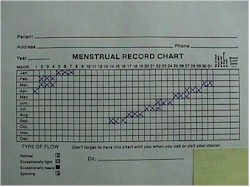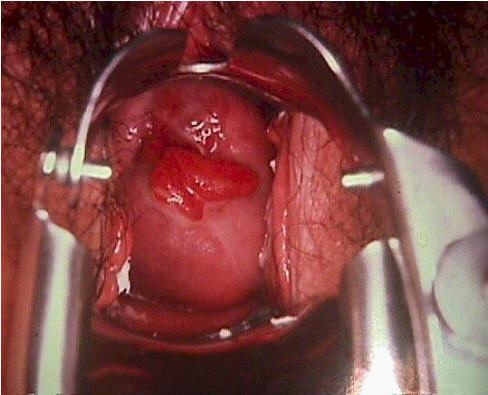|
Normal menstrual bleeding:
- Occurs approximately once a month (every 26 to 35
days).
- Lasts a limited period of time (3 to 7 days).
- May be heavy for part of the period, but usually does
not involve passage of clots.
- Often is preceded by menstrual cramps, bloating and
breast tenderness, although not all women experience these
premenstrual symptoms.
Abnormal Bleeding
Abnormal bleeding (DUB or dysfunctional uterine bleeding)
includes:
- Too frequent periods (more often than every 26 days).
- Heavy periods (with passage of large, egg-sized
clots).
- Any bleeding at the wrong time, including spotting or
pink-tinged vaginal discharge
- Any bleeding lasting longer than 7 days.
- Extremely light periods or no periods at all
|
 Overview
Any woman complaining of abnormal vaginal bleeding should
of course be examined. Occasionally, you will find a laceration of the
vagina, a bleeding lesion, or bleeding from the surface of the cervix
due to cervicitis. Much more commonly, you will find bleeding from the
uterus coming out of the cervical os.
Excluding pregnancy, there are really only three reasons
for abnormal uterine bleeding:
- Mechanical Problems
- Hormonal Problems
- Malignancy
The limited number of possibilities makes your caring for
these patients very simple. First, before examining the patient,
obtain a pregnancy test. If it is positive, then don't do anything
more until you've read about the different possible causes.
Next, obtain a blood count and assess the rate of blood
loss to determine how much margin of safety you have. Someone with a
good blood count (hematocrit) and minimal rate of blood loss (less
than a heavy period), can tolerate this rate of loss for many days to
weeks before the bleeding itself becomes a threat.
Pregnancy Problems
A variety of pregnancy problems can cause
vaginal bleeding. These include:
-
Abortion (threatened, incomplete, complete, missed,
or inevitable)
-
Ectopic Pregnancy
-
Placental Abruption
-
Placenta Previa
If the bleeding patient has a positive
pregnancy test, a careful search should be made for each of these
problems. However, if the pregnancy test is negative,
pregnancy-related bleeding problems are effectively ruled out.
Mechanical Problems
Such problems as uterine fibroids or polyps
are examples of mechanical problems inside the uterus.
Since mechanical problems have mechanical
solutions, these patients will need surgery of some sort (Polypectomy,
D&C, Hysteroscopy, Hysterectomy, Myomectomy, etc.) to resolve their
problem.
In the meantime, have them lie still and the
bleeding will improve or temporarily go away. Giving hormones (like
birth control pills) in an effort to stop the bleeding will not help
this condition, but neither will it be harmful.
Polyps visible protruding from the cervix
are usually coming from the cervix and can be easily twisted off.
However, they will need microscopic evaluation, so removal in many
operational settings may not be desired. Instead, they can await
return to a non-deployed setting.
Another form of mechanical problem is an IUD
causing abnormal bleeding. These should always be removed.
From:
Operational Obstetrics & Gynecology
2nd Edition
NAVMEDPUB 6300-2C
Bureau of Medicine and Surgery
Department of the Navy
Continue
to the PowerPoint Lecture... |


